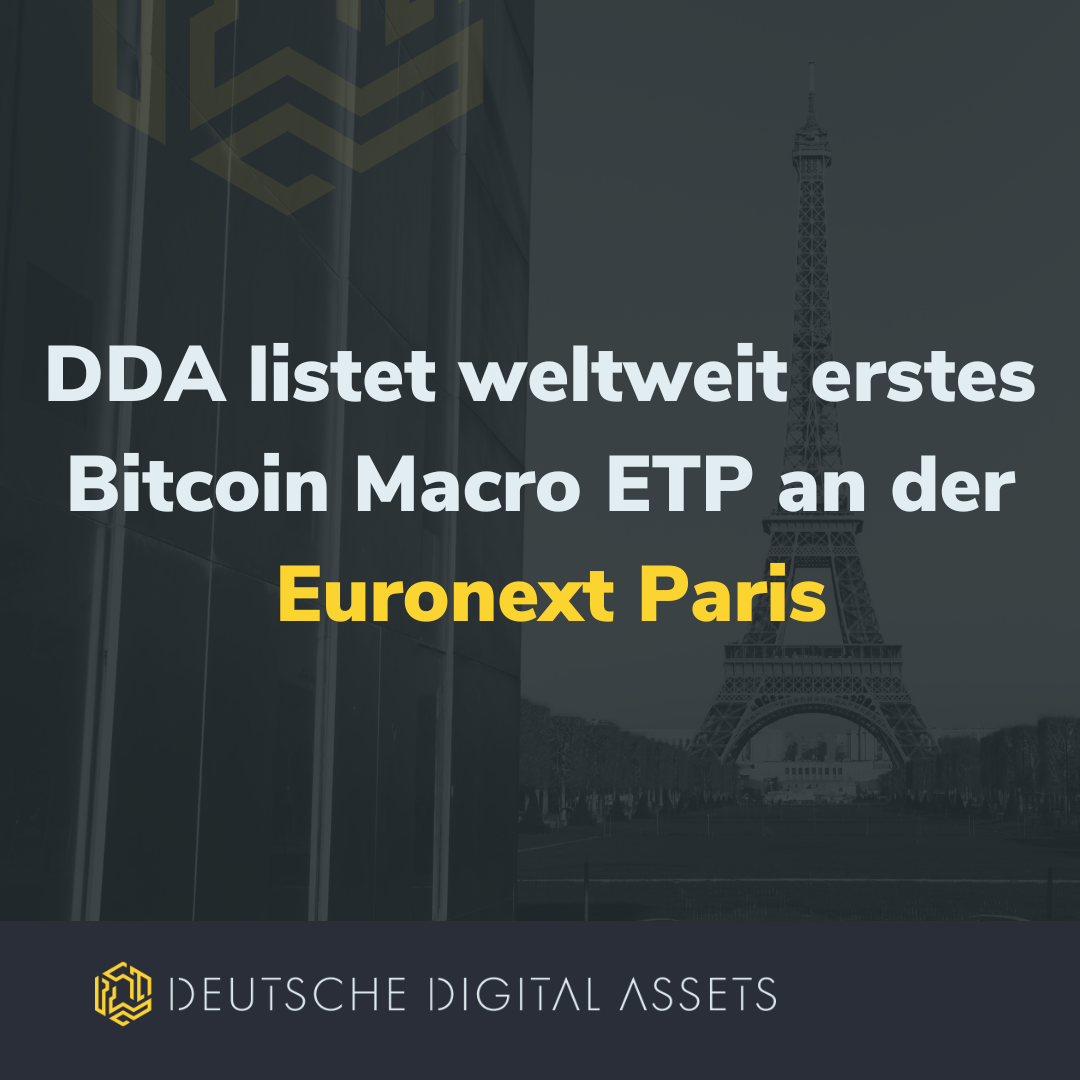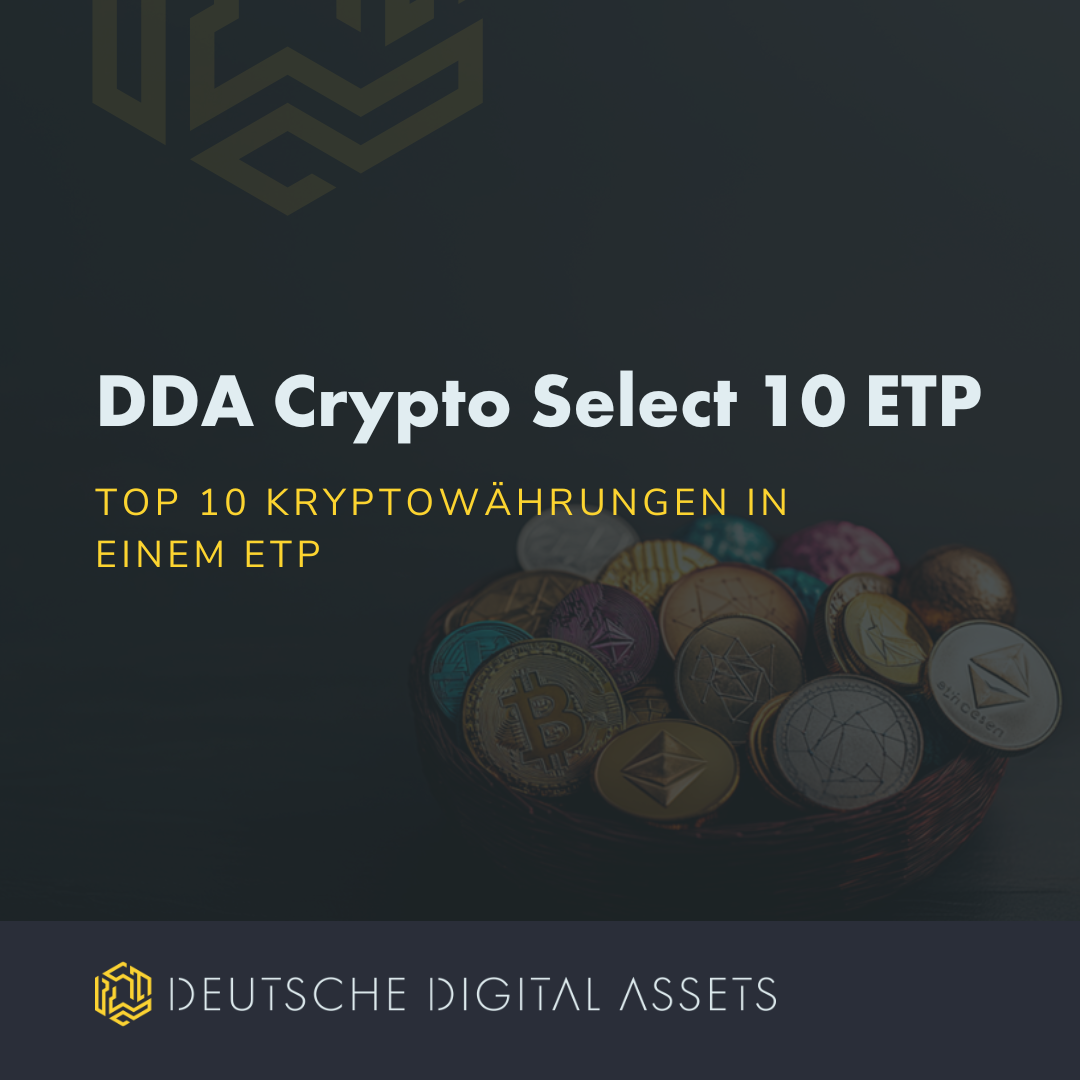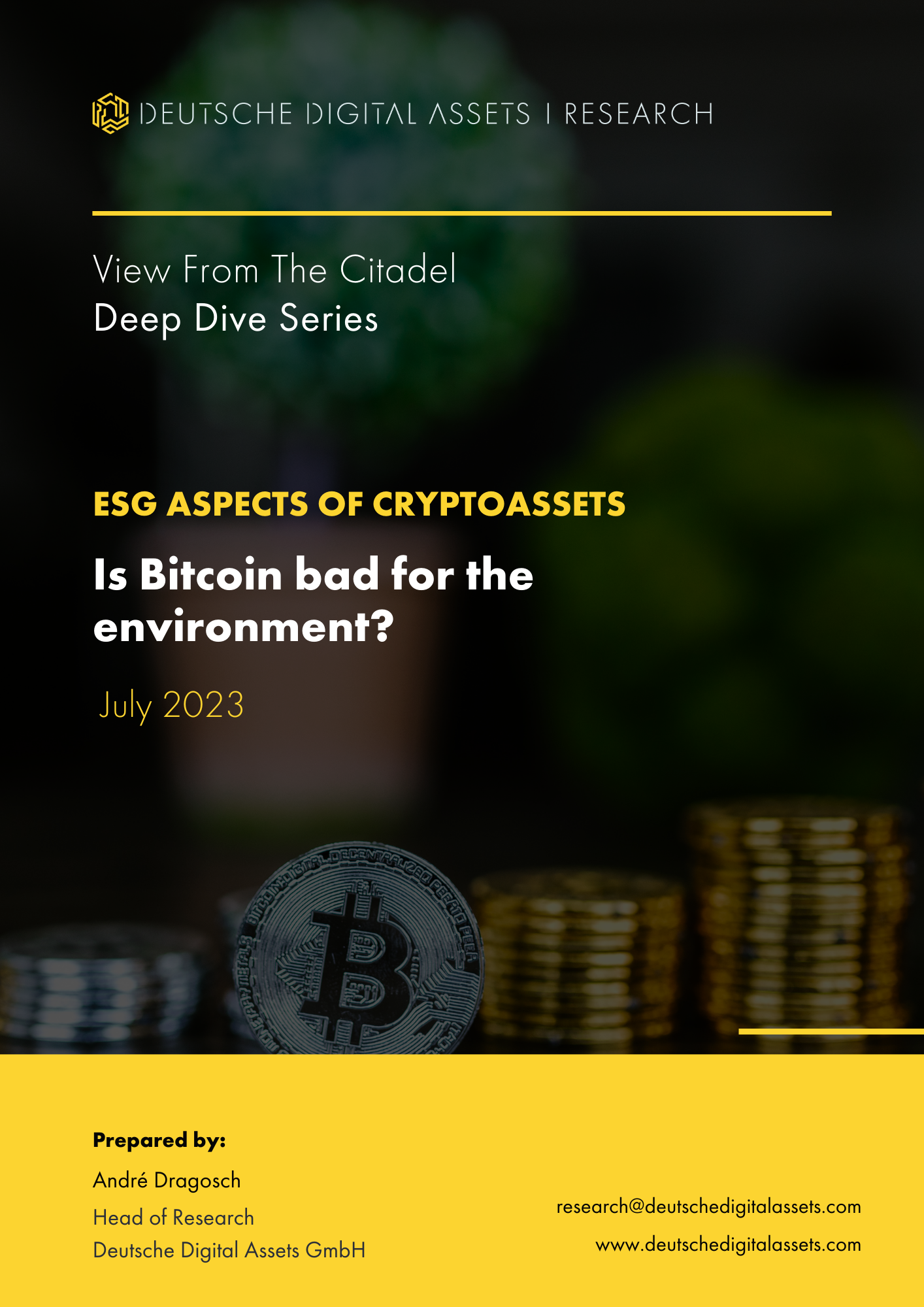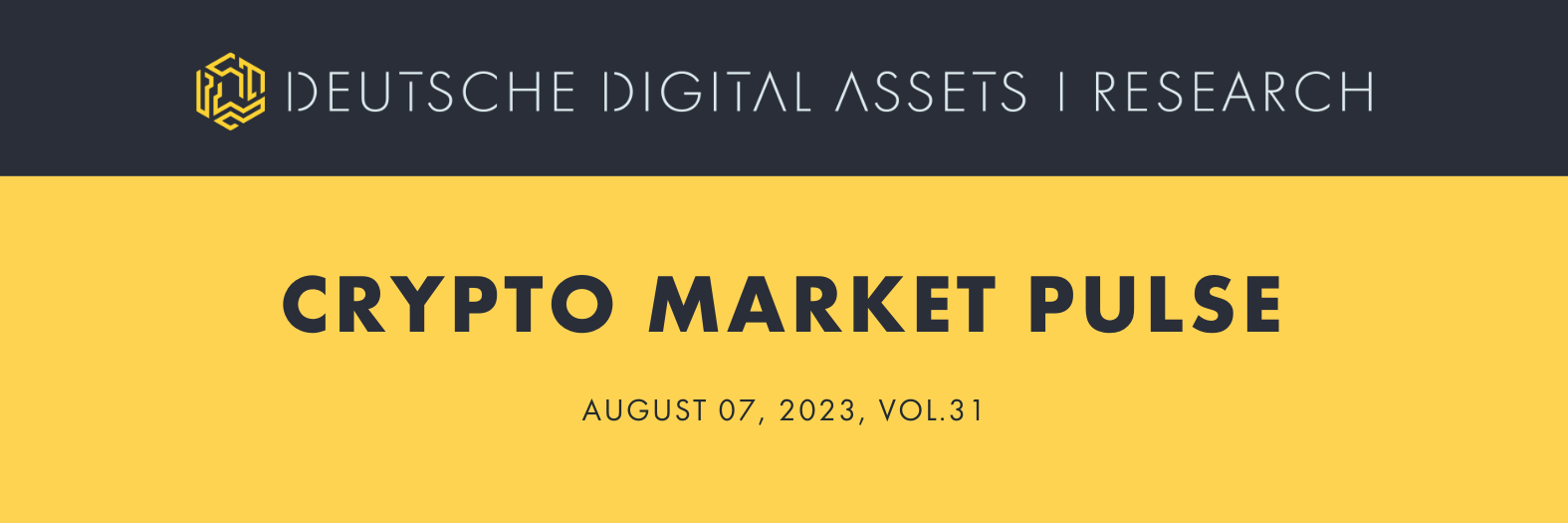
Bitcoin’s Volatility Hits Yearly Low, Cryptoassets Post a Weak Performance Amidst Wider Capital Markets’ Risk-Off Sentiment
DDA Crypto Market Pulse, August 07, 2023
von André DragoschLeiter der Forschung
Wichtigste Erkenntnisse
- Last week, cryptoassets posted a weak performance consistent with a general risk-off sentiment in the wider capital markets
- Our in-house Crypto Sentiment Index has increased slightly compared to last week
- At the same time, Bitcoin’s realized volatility over the past 10 days has collapsed to the lowest level year-to-date amid low transfer volumes
Chart der Woche
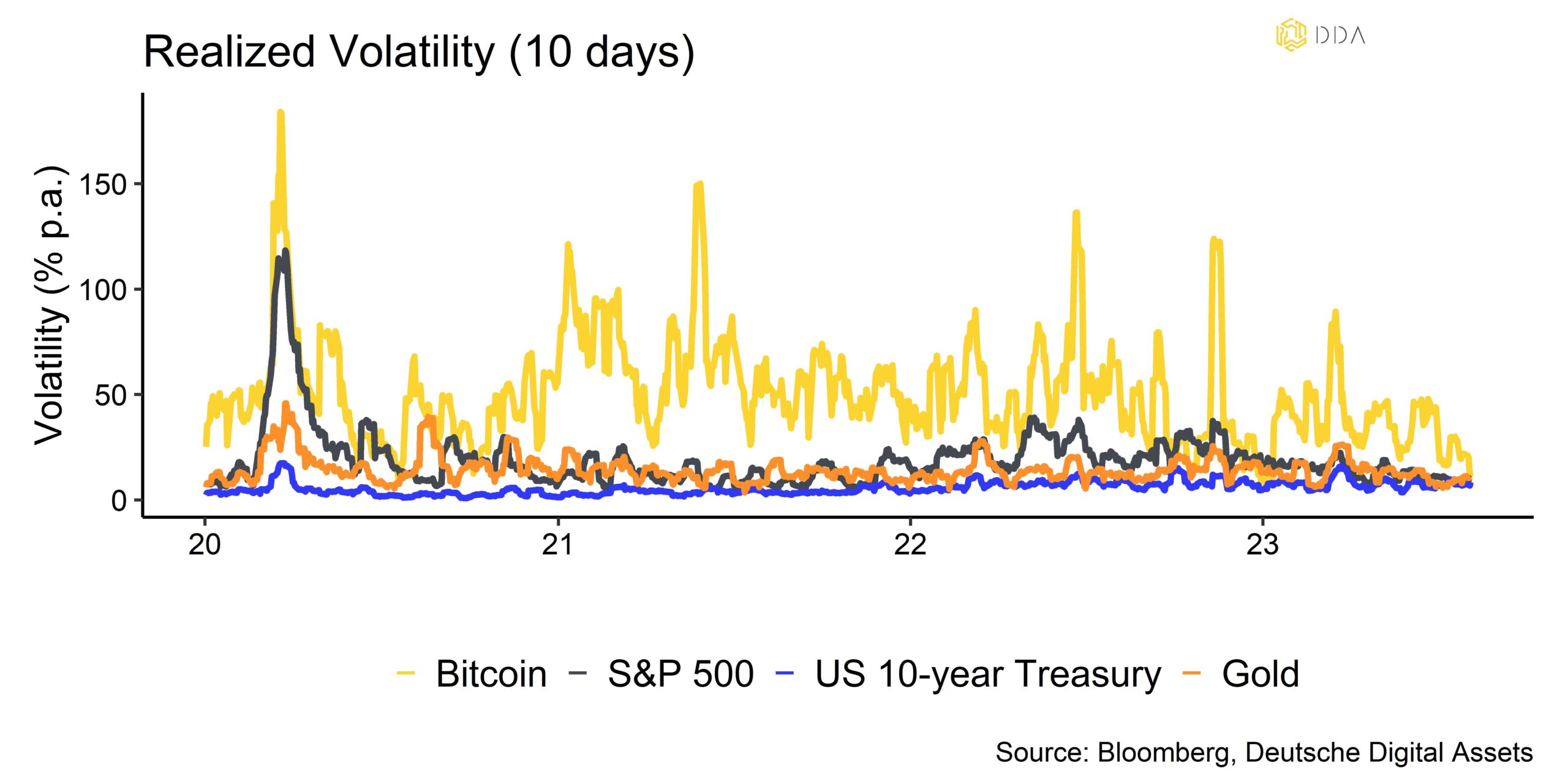
Kryptoasset Leistung
Last week, cryptoassets posted a weak performance consistent with a general risk-off sentiment in the wider capital market due to robust US employment data that suggested “higher for longer” in interest rates. Global equities, bonds and commodities all retreated last week, while the Dollar appreciated. At the same time, Bitcoin’s realized volatility over the past 10 days has collapsed to the lowest level year-to-date amid low transfer volumes and is now in line with other traditional assets (Chart-der-Woche).
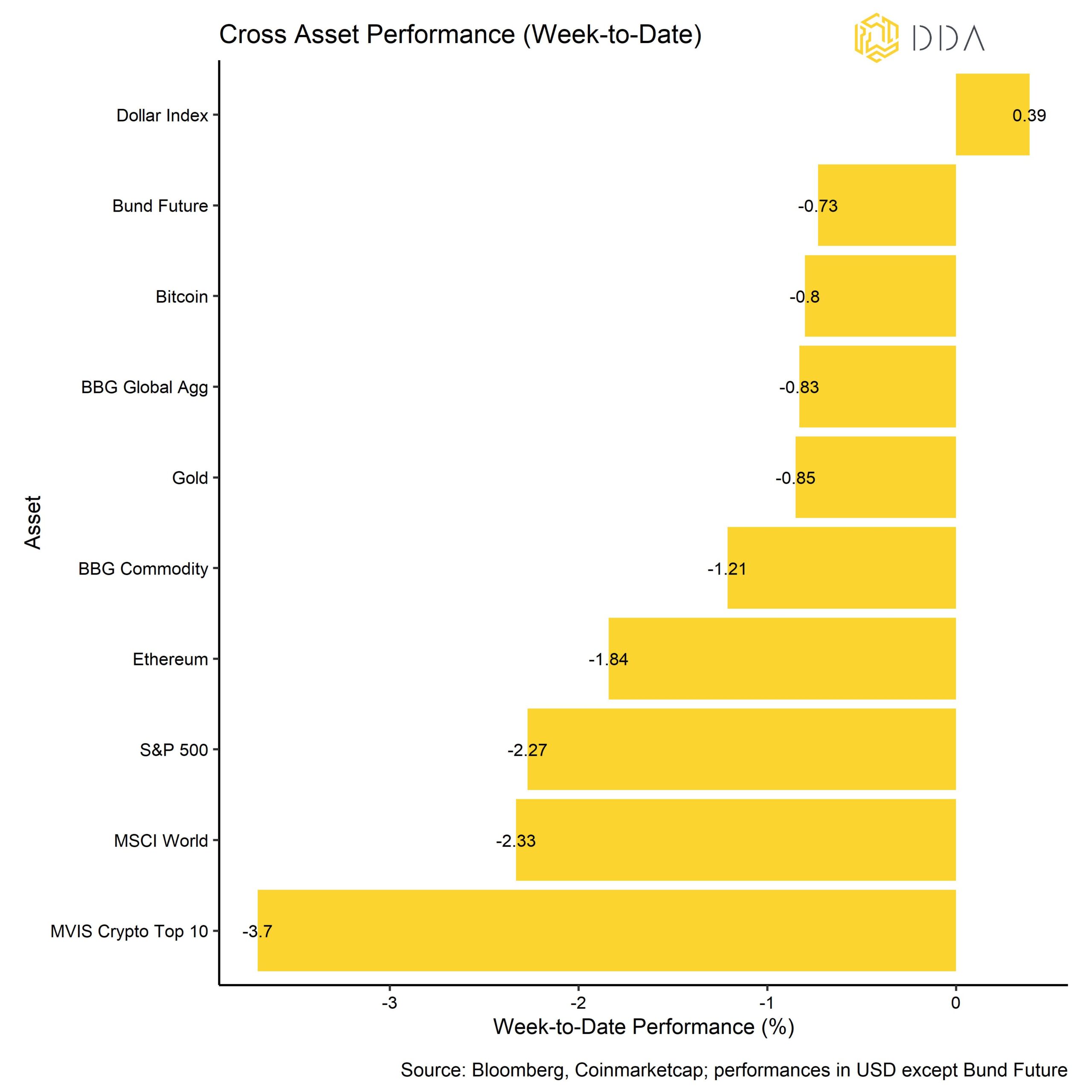
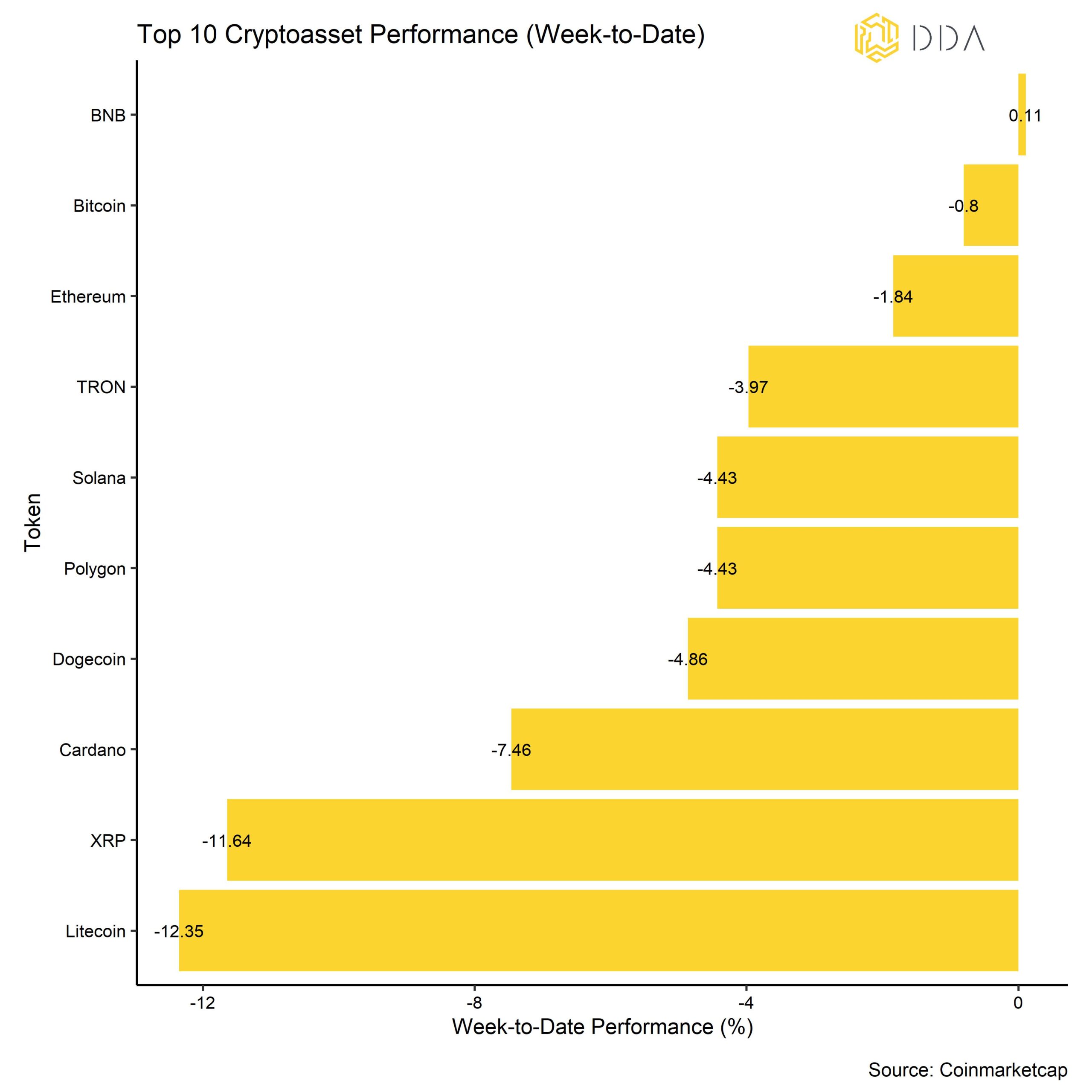
mong the top 10 cryptoassets, BNB, Bitcoin, and Ethereum were the relative outperformers.
In general, altcoin outperformance vis-à-vis Bitcoin decreased significantly last week. Based on our set of tracked altcoins only 20% of altcoins were able to outperform Bitcoin on a weekly basis.
Krypto-Marktstimmung
Our in-house Crypto Sentiment Index has increased slightly compared to last week. 8 out of 15 indicators are still above their short-term trend.
Compared to last week, we saw major reversals to the upside in the BTC 1-month option skew and BTC perpetual funding rates.
The Crypto Fear & Greed Index remains in “Neutral” territory as of this morning.
Performance dispersion among cryptoassets has slightly but remains at high levels.
In general, high performance dispersion among cryptoassets implies that correlations among cryptoassets is low which means that cryptoassets are trading more on coin-specific factors.
At the same time, as mentioned above, altcoin outperformance has declined significantly last week and is now at 20% of altcoins outperforming Bitcoin on a weekly basis.
In general, altcoin outperformance goes hand in hand with an increase in crypto dispersion, i.e. Bitcoin and altcoins are generally trading up during “altseason” with altcoins outperforming Bitcoin. Broader altcoin outperformance is usually a sign of increasing risk appetite and broader altcoin underperformance a sign of increasing risk aversion.
Krypto Asset Flows
Last week saw larger net outflows from global crypto ETPs.
In aggregate, we saw net fund outflows in the amount of -70.2 mn USD (week ending Friday).
Accordingly, Bitcoin funds and Ethereum funds experienced significant net outflows (-72.7 mn USD and -4.5 mn USD on a net basis, respectively).
In contrast, Altcoin-based funds experienced net inflows (+9.3 mn USD).
However, thematic & basket crypto funds also experienced net outflows -2.3 mn USD last week.
Besides, the NAV discount of the biggest Bitcoin fund in the world – Grayscale Bitcoin Trust (GBTC) – has more or less moved sideways last week which implies neither significant net inflows nor outflows from this fund vehicle.
Furthermore, the beta of global crypto hedge funds to Bitcoin over the last 20 trading days decreased to 0.5, implying that global crypto hedge funds have somewhat decreased their net exposure to cryptoassets. The crypto hedge funds’ beta to Bitcoin is currently at a 3-year low, implying that crypto hedge funds are generally underexposed to market risk of cryptoassets.
On-Chain Tätigkeit
As mentioned in the introduction, Bitcoin’s 10-days realized volatility has declined to the lowest level year-to-date. In fact, Bitcoin has run 11 consecutive days without a 1% move in either direction.
One of the major reasons is that on-chain transfer volumes in BTC-terms have declined to a 3-year low. So, there is generally not much activity in terms of network usage. Exchange volumes (in- and outflows) have also declined. Active addresses have increased but are still below year-to-date highs. On a positive note, new address momentum has continued to pick up recently, so more new users are entering. Transaction count has also increased but remains below the high levels seen during the ‘inscription frenzy’ in May. Transaction fees are also relatively low which also implies low demand for block space.
Investors should keep in mind though, that periods of low volatility beget periods of high volatility and vice versa – a phenomenon which is called ‘volatility clustering’.
Bitcoin whales (wallets > 1k BTC) appear to be on the move as we have outlined in our latest Crypto Market Intelligence report with a the amount of net transfer volumes to exchanges by whales reaching an all-time high. Although many on-chain analysts have attributed this to ‘wallet reshuffling’ this still poses a potential downside risk.
Nonetheless, long-term holders continue to accumulate coins with the %-age of supply by these types of investors reaching a new all-time high and there are not many transfers to exchanges by these types of investors at the moment.
Krypto-Asset-Derivate
Last week, derivatives metrics continued to suggest a rather muted price action.
For instance, BTC 1-month implied volatilities reached a new all-time low of 30% p.a. as option traders seem to expect a rather calm market environment for Bitcoin. This was also consistent with the decline in realized volatility.
BTC Put-Call-Ratios both in terms of open interest and trading volume were also relatively low. The BTC 1-month 25-delta option skew decreased slightly and is still biased towards calls implying that BTC option traders have net positive expectations of future market developments.
The BTC 3-months basis rate increased again above 5% p.a. which means that the BTC futures curve steepened slightly.
However, BTC derivatives open interest increased significantly throughout the week for futures (calendar & perpetual) and reached the highest level year-to-date. Option open interest also increased but remains well below the high levels seen in March this year.
Unterm Strich
Last week, cryptoassets posted a weak performance consistent with a general risk-off sentiment in the wider capital markets.
Our in-house Crypto Sentiment Index has increased slightly compared to last week.
At the same time, Bitcoin’s realized volatility over the past 10 days has collapsed to the lowest level year-to-date amid low transfer volumes.
Über DDA Deutsche Digital Assets
Deutsche Digital Assets (DDA) ist ein deutscher Digital Asset Manager, der als vertrauenswürdige Anlaufstelle für Investoren dient, die ein Exposure zu Krypto Assets suchen. Über verschiedene Tochtergesellschaften bietet DDA eine Reihe von kryptobezogenen Anlageprodukten an, die von passiven bis hin zu aktiv verwalteten Investmentlösungen reichen. Darüber hinaus bietet das Unternehmen professionelle Anlageberatung für Family Offices, High Net Worth Individuals (HNWI) und institutionelle Anleger an.
Wir bieten hervorragende Leistungen durch vertraute, vertrauenswürdige Anlagevehikel, die den Anlegern die Qualitätsgarantien bieten, die sie von einem erstklassigen Vermögensverwalter verdienen, während wir uns für unsere Mission einsetzen, die Akzeptanz von Kryptoanlagen zu fördern. DDA beseitigt die technischen Risiken von Krypto-Investitionen, indem wir Anlegern vertrauenswürdige und vertraute Mittel zur Investition in Krypto zu branchenführend niedrigen Kosten anbieten.
Haftungsausschluss
Die in diesem Artikel enthaltenen Materialien und Informationen dienen ausschließlich zu Informationszwecken. Die Deutsche Digital Assets, ihre verbundenen Unternehmen und Tochtergesellschaften fordern nicht zu Handlungen auf der Grundlage dieses Materials auf. Dieser Artikel ist weder eine Anlageberatung noch eine Empfehlung oder Aufforderung zum Kauf von Wertpapieren. Die Wertentwicklung ist unvorhersehbar. Die Wertentwicklung in der Vergangenheit ist daher kein Hinweis auf die zukünftige Wertentwicklung. Sie erklären sich damit einverstanden, Ihre eigenen Nachforschungen anzustellen und Ihre Sorgfaltspflicht zu erfüllen, bevor Sie eine Anlageentscheidung in Bezug auf die hier besprochenen Wertpapiere oder Anlagemöglichkeiten treffen. Unsere Artikel und Berichte enthalten zukunftsgerichtete Aussagen, Schätzungen, Projektionen und Meinungen. Diese können sich als wesentlich ungenau erweisen und unterliegen erheblichen Risiken und Unwägbarkeiten, die außerhalb der Kontrolle der Deutsche Digital Assets GmbH liegen. Wir gehen davon aus, dass alle hierin enthaltenen Informationen korrekt und zuverlässig sind und aus öffentlichen Quellen stammen. Diese Informationen werden jedoch "wie besehen" und ohne jegliche Garantie präsentiert.









